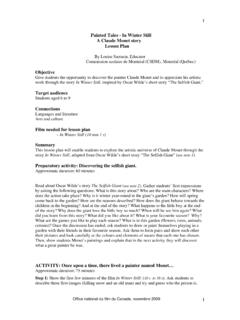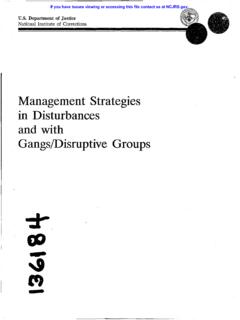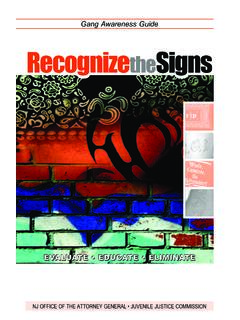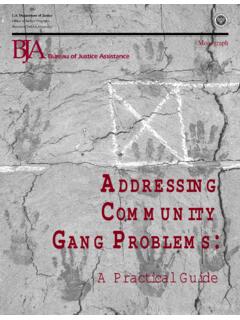Transcription of TEACHER’S GUIDE
1 TEACHER'S GUIDE . A NATIONAL FILM BOARD OF CANADA PRODUCTION. TEACHER'S GUIDE . synopsis Cree filmmaker Neil Diamond takes an entertaining and insightful look at the Hollywood Indian, exploring the portrayal of Aboriginal peoples through a century of cinema. With clips from hundreds of classic and recent films, reel injun traces the evolution of cinema's depiction of Native peoples from the silent-film era to today, only to find the future of Aboriginal cinema in the unlikeliest of places: Canada's North. Rambling through the heartland of America, Diamond looks at how the myth of the injun has influenced the world's representation and misrepresentation of Native peoples.
2 The Cree filmmaker conducted candid interviews with Native and non-Native film celebrities as well as activists, film critics and historians. reel injun is a documentary about cinema through the perspectives of the people who appeared in its very first flickering images and have survived to this day to tell their own stories with their own cameras. Diamond meets with Clint Eastwood (The Good, the Bad and the Ugly, A Fistful of Dollars, Unforgiven) at his studios in Burbank, California. The famous actor discusses the evolution of the image of Native Americans in westerns and what cowboy-and-Indian myths mean to America. Legendary Native American activists John Trudell, Russell Means and Sacheen Littlefeather take hold of the talking stick to critique the history of Hollywood and its promotion of stereotypes and racism, and discuss how it played a significant role in the rise of the American Indian Movement (AIM).
3 reel injun : ON THE TRAIL OF THE HOLLYWOOD INDIAN 1. Celebrities featured in reel injun include Robbie Robertson, the Mohawk musician and soundtrack composer (Raging Bull, Casino, Gangs of New York), Cherokee actor Wes Studi (Last of the Mohicans, Geronimo), filmmakers Jim Jarmusch (Dead Man) and Chris Eyre (Smoke Signals) and acclaimed Native actors Graham Greene (Dances with Wolves, Thunderheart) and Adam Beach (Smoke Signals, Clint Eastwood's Flags of Our Fathers). Diamond also travels north to the remote Nunavut town of Igloolik (population: 1,500) to interview Zacharias Kunuk, director of the Cam ra d'Or-winning Atanarjuat (The Fast Runner).
4 reel injun 's humour and star power are balanced with insightful commentary from film critics and historians, including CBC film critic Jesse Wente, author and American Indian studies scholar Angela Aleiss, and Melinda Micco, associate professor of ethnic studies at Mills College, California. In reel injun , Diamond takes the audience on a journey across America to some of cinema's most iconic landscapes, including Monument Valley, the setting for Hollywood's greatest westerns, and the Black Hills of South Dakota, home to Crazy Horse and countless movie legends. Overview This teaching GUIDE contains discussion topics and questions grouped into key topic areas, chapters and themes, giving educators the flexibility to present excerpts from reel injun or the entire movie.
5 reel injun is suitable for classroom use in secondary and post-secondary education, in courses such as film studies, social studies, media and communications, ethics and history. Cree filmmaker Neil Diamond, from northern Quebec (near the Arctic Circle), has made a documentary tracing the history of Hollywood's representation of Native Americans. reel injun is a rich tool to examine the most serious issues regarding these depictions, including topics such as: . Injuns in Hollywood . What is the difference between an injun and a human being? . The evolution of the image of Indians in westerns . Cowboy-and-Indian myths: What do they mean to North America?
6 What are the effects of negative stereotypes on Native people? . Native activism (American Indian Movement).. Identities and cultural exchanges Audience age: Suitable for ages 15+. This documentary addresses grave or controversial issues regarding the portrayal of Aboriginal peoples. Educators are encouraged to preview the film and research background information to contextualize these situations before screening the film in class. TEACHER'S GUIDE 2. Film themes: Main Points AND Discussion Questions You can enjoy reel injun in an extended viewing or over several class periods. The film is chaptered by themes so you have the option of showing selected segments.
7 Following are some main points and possible discussion questions. Native Representation reel injun Chapter 1. Main points: Over 4,000 films shaped the image of the Native American in the last century, some offering stereotypical images, such as They Died with Their Boots On, others providing a more accurate focus, like Little Big Man, One Flew Over the Cuckoo's Nest and Dances with Wolves, and some that are free of stereotypes, like Smoke Signals and Atanarjuat. When Native peoples watch Indians on television and cheer for the cowboys, there is a major problem of representation. Distorted images have caused a great deal of damage. Discussion questions: What are the consequences of distorted representations of Native people with regard to their identity, self-esteem and social and cultural development?
8 One hundred years of cinema have shaped the folkloric images of Native Americans to the point that some people believe that Indians still live in teepees. But what is an injun in 2011? Native Americans from Hollywood to Wounded Knee Birth of the Hollywood injun Chapter 2. Main points: Early movie images depicted the injun as spiritual, noble and free. In the late 19th century, Thomas Edison filmed Laguna Pueblo dances that were shown for a penny in the peep shows in Times Square in New York City. But while the savages in the reels were dancing, some 300 women, men and children were being killed in the Wounded Knee Massacre on the Pine Ridge Reservation.
9 Discussion questions: What were the main reasons for Native people being so widely represented in the movies? Some say that cinema was created to film First Nations people; on what basis can we support such a statement? Why would American culture treat Indians as myths or dinosaurs? In the movies, all Native people are supreme horsemen, at one with their horses, but most of them can't ride in real life. How was such a myth created? The Good Indian The Noble injun Chapter 3. Main points: During the silent-film era, Indians became stars. The Native American perspective was seen for the first time. Native filmmakers directed their own movies and brought their own people to play the characters.
10 The Silent Enemy (H. P. Carver) explores starvation and the idea of the Native vanishing. In those days, it was cool to be portrayed as Native. Discussion questions: The silent era portrayed Native people as noble; how did that come to be? Why are some people excited by the idea of being Native regardless of the bad image projected by Hollywood? Do you think that the kids in the summer camp sequence in reel injun were only encountered Native people in Hollywood movies? According to Hollywood's criteria, what does it take to be a good or noble Indian? reel injun : ON THE TRAIL OF THE HOLLYWOOD INDIAN 3. Tonto Speech and Stereotypes The Savage injun Chapter 4.








